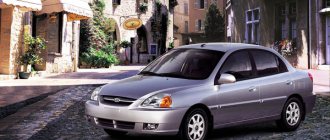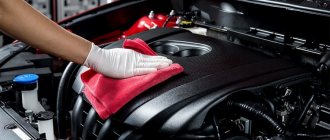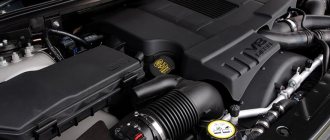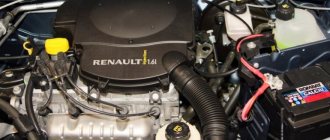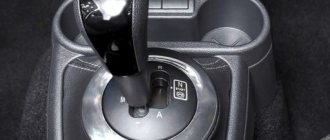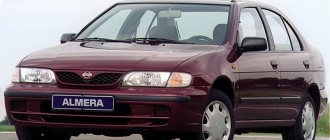Model review: VAZ 2104 without embellishment
Few people know that the VAZ 2104 (“four”) also bears the foreign name Lada Nova Break. This is a five-seater station wagon, which belongs to the second generation of AvtoVAZ “classics”.
The first models left the factory in September 1984 and thereby replaced the first generation station wagon - VAZ 2102. Although for another year (until 1985) the Volzhsky Automobile Plant produced both models simultaneously.
"Four" - the first station wagon in the VAZ line
VAZ 2104 cars were created on the basis of the VAZ 2105, only they had significant differences:
- extended rear part;
- folding rear bench;
- increased gas tank up to 45 liters;
- rear wipers with washer.
It must be said that the “four” were actively exported to other countries. In total, 1,142,000 VAZ 2104 units were produced.
Export model for the Spanish car market
Along with the VAZ 2104, its modification was also produced - the VAZ 21043. This is a more powerful car with a 1.5 liter carburetor engine and a five-speed gearbox.
Video: review of the Quartet
Modifications of diesel "fours"
During the history of the production of the four, 2 diesel fuel modifications were designed:
The first version of the station wagon began to be produced in small batches in 1999. Equipped with an engine of Barnaul origin - VAZ-341. Technical specifications provide a power of only 50 horsepower with a volume of 1.5 liters. You can understand whether this is not enough or not by comparing it with the “horses” of the 1.3-liter gasoline “four”, the maximum of which is 64 horsepower. The unit is equipped with four cylinders, 2 valves each. The manufacturer of the high pressure fuel pump is German.
Specifications
A car in a station wagon weighs a little, only 1020 kg (for comparison: the “five” and “six” in a sedan body weigh more - from 1025 kg). The dimensions of the VAZ 2104, regardless of the configuration, are always the same:
- length - 4115 mm;
- width - 1620 mm;
- height - 1443 mm.
The base of the “five” was significantly improved and modified.
Thanks to the folding rear row, the trunk volume can be increased from 375 to 1340 liters, which made it possible to use the car for private transportation, country work and even small businesses. However, the back of the rear sofa does not fold entirely (due to the specific design of the car), so it is impossible to transport long cargo.
Trunk capacity can be easily increased with folding rear seats
However, long elements are easy to fix on the roof of the car, since the length of the VAZ 2104 allows you to transport beams, skis, boards and other long items without the risk of creating dangerous road situations. But you cannot overload the roof of the car, since the calculated rigidity of the station wagon body is much lower than that of sedans of the next generations of VAZ.
Transportation of goods is possible not only in the trunk, but also on the roof of the car
The total load on the vehicle (passengers + cargo) should not exceed 455 kg, otherwise damage to the chassis may occur.
The “Four” was equipped with two types of drives:
- FR (rear-wheel drive) is the basic equipment of the VAZ 2104. Allows you to make the car more powerful.
- FF (front-wheel drive) - selected models were equipped with front-wheel drive, as it is considered safer; subsequent versions of the VAZ began to be produced only in front-wheel drive.
Like other Lada representatives, the Four has a ground clearance of 170 mm. Even today, this is a completely reasonable ground clearance, allowing you to overcome major road obstacles.
Engine characteristics
Over the years, the VAZ 2104 was equipped with power units of different power: from 53 to 74 horsepower (1.3, 1.5, 1.6 and 1.8 liters). Two modifications (21048D and 21045D) used diesel fuel, but all other versions of the “four” consumed AI-92 gasoline.
The model was equipped exclusively with carburetor units
Depending on the engine power, fuel consumption also varies.
| Options | Fuel consumption, l/100 km | Fuel used |
| 1.8MT 21048D | 5,5 | Diesel fuel |
| 1.5MT 21045D | 8,6 | Diesel fuel |
| 1.6MT 21041 | 8,8 | Gasoline AI-92 |
| 1.3MT 2104 | 10,0 | Gasoline AI-92 |
| 1.5MT 21043i | 10,3 | Gasoline AI-92 |
| 1.5MT 21043 | 10,3 | Gasoline AI-92 |
The VAZ 2104 accelerates to a speed of 100 km/h in 17 seconds (this is a standard indicator for all VAZs produced in the 1980–1990s). The maximum speed of the machine (according to the operating instructions) is 137 km/h.
Table: parameters of the “four” motor
| Number of cylinders: | 4 |
| Cylinder displacement, l: | 1,45 |
| Compression ratio: | 8,5 |
| Rated engine power at a crankshaft speed of 5000 rpm: | 50.0 kW.- (68.0 hp) |
| Cylinder diameter, mm: | 76 |
| Piston stroke, mm: | 80 |
| Number of valves: | 8 |
| Minimum crankshaft speed, rpm: | 820–880 |
| Maximum torque at 4100 rpm, N*m: | 112 |
| Cylinder operating order: | 1–3-4–2 |
| Octane number of gasoline: | 95 (unleaded) |
| Fuel supply system: | Electronically controlled distributed injection |
| Spark plug: | А17ДВРМ, LR15YC-1 |
Latest experiments
In 2007, Tema Plus installed an FNM engine on Chevrolet Niva for individual orders.
In 2014, on Lada 4x4 they experimented with 1.3 l 75 l. With. Fiat Multijet engine. However, it was not compatible with either the transmission due to torque limitations, or with the analog wiring diagram due to the CAN bus.
Super-auto explored the possibility of installing a 4x4 1.5 liter diesel engine from Renault Duster on the Lada 4x4 by 2015. In addition, an experimental car was created with a 100-horsepower 1.8 liter engine.
Vehicle interior
The original interior of the VAZ 2104 has an ascetic design. All devices, parts and products are designed to perform their functions; there are no decorations or even a hint of any design solution. The task of the model's designers was to make a working car, suitable for passenger and cargo transportation, without focusing on comfort and beauty.
The interior contains the minimum necessary set of instruments and vehicle controls, standard upholstery in wear-resistant fabric and removable faux leather headrests on the seats. The picture is complemented by standard rubber mats on the floor.
The design of the Four's interior was borrowed from the base model, with the exception of the rear sofa, which was made foldable for the first time in the history of VAZ models.
Video: review of the Quartet’s interior
VAZ 2104 cars were discontinued in 2012. Therefore, even today you can meet amateurs who do not change their beliefs and use only time-tested and road-tested domestic cars.
The VAZ 2104 belongs to the “Classics” family of vehicles produced by AvtoVAZ. Many engines of this series were installed on the car, which makes them typical for this model range. The power units were remembered for their reliability and budget performance.
Specifications
The VAZ 2104 engine has typical technical characteristics of AvtoVAZ engines. In fact, vehicles of the 2104 model were equipped with power units of different markings, and the manufacturer did not produce an engine marked 2104. Thus, engines with the following markers were installed on the “four”: 2103, 2105, 21067, 21073 and 341. Let us consider in more detail the technical characteristics of each power unit:
VAZ 2103
| Name | Characteristic |
| Brand | 2103 |
| Type | Gasoline with the possibility of installing LPG |
| Injection system | Carburetor |
| Volume | 1.5 liters (1458 cm3) |
| Power | 80 hp |
| Number of cylinders | 4 |
| Number of valves | 8 |
| Consumption | 8.5 liters |
| Econorm | Euro 2 |
VAZ 2105
| Name | Characteristic |
| Brand | 2105 |
| Type | Gasoline with the possibility of installing LPG |
| Injection system | Carburetor |
| Volume | 1.3 liters (1290 cm3) |
| Power | 54 hp |
| Number of cylinders | 4 |
| Number of valves | 8 |
| Consumption | 9.2 liters |
| Econorm | Euro 2 |
VAZ 21067
| Name | Characteristic |
| Brand | 21067 |
| Type | Gasoline with the possibility of installing LPG |
| Injection system | Carburetor |
| Volume | 1.6 liters (1569 cc) |
| Power | 82 hp |
| Number of cylinders | 4 |
| Number of valves | 8 |
| Consumption | 8.5 liters |
| Econorm | Euro 2 |
VAZ 21073
| Name | Characteristic |
| Brand | 21073 |
| Type | Gasoline with the possibility of installing LPG |
| Injection system | Injector |
| Volume | 1.7 liters (1689 cc) |
| Power | 84 hp |
| Number of cylinders | 4 |
| Number of valves | 8 |
| Consumption | 9.5 liters |
| Econorm | Euro 2 |
VAZ 341
| Name | Characteristic |
| Brand | 341 |
| Type | Diesel |
| Injection system | Injector |
| Volume | 1.5 liters (1524 cm3) |
| Power | 50 hp |
| Number of cylinders | 4 |
| Number of valves | 8 |
| Consumption | 6.7 liters |
| Econorm | Euro 2 |
All engines in the series used a lightweight flywheel and a standard VAZ clutch. The 2104 engine was equipped with two types of gearboxes - a 4-speed and a 5-speed manual transmission.
Borrowed engines
Since it did not have its own mass-produced passenger diesel, VAZ repeatedly borrowed third-party engines.
Thus, in 1981, the possibility of converting the VAZ-2121 gasoline engine into a diesel engine was considered with the participation of Porche.
From 1987 to 1990, the manufacturer, together with the German importer Deutsche Lada, developed a plan to create an export version of the Niva with a Volkswagen power unit. However, this company refused to adapt its 1.9 liter engine to the Niva platform.
In 1993, we managed to establish cooperation along the same lines with Peugeot. By order of the French importer Jean Poka, the manufacturer adapted the 1.9 liter XUD-9L engine for installation on the VAZ-2121. The production of the cars was carried out by Lada-Export. Regular Nivas were delivered there, and the standard engine was replaced with a French one. In total, about 6,000 of these cars were produced for France, Spain, Italy and other European markets.
In addition, in Italy, Martorelli equipped Nivas with VM and FNM engines.
However, with the introduction of Euro-2 environmental standards, small-scale production of diesel Nivas was completed.
In 1998, together with Peugeot and Martorelli, VAZ tried to establish production of Nivs with the Peugeot XUD-9SD engine. However, work also had to be stopped due to the introduction of Euro-3 standards.
In addition, from 1995 to 1997, Samara was equipped with a PSA TDU5 engine from Peugeot 106 and Citroen Saxo with third-party attachments and original mounting for the French and Benelux markets.
Service
Servicing VAZ engines, which are classified as “classics”, is quite simple, since the structure is the same, only the volume changes. According to the technical documentation, the service standard is 10,000 km. After this mileage, the engine needs to replace the lubricant and filter element.
In addition to standard maintenance procedures, other elements also change depending on the mileage. So, every 20,000 km the air filter is changed. Upon expiration. 40,000 km it is necessary to replace the gas distribution mechanism kit.
If the replacement is not done in a timely manner, the belt (or chain) may break, which will cause bent valves, and even worse, bending of the cylinder head or other consequences that will lead to premature overhaul.
Change of oil
Perhaps the most common and frequently performed repair operation is changing the oil and oil filter. Consider the sequence of actions:
- Before starting repair and restoration operations, you should remove the negative terminal from the battery.
- If there is engine protection, it must be removed. To do this, you need to unscrew the mounting bolts.
- Next, unscrew the drain plug, which is located on the pan, and wait for the lubricant to drain.
- We tighten the drain plug, while not forgetting to change the copper sealing gasket.
- Using a special puller, remove the oil filter. Before installing a new one, you need to pour 100 grams of new oil into it.
- Unscrew the filler neck and pour in the oil.
- After tightening the filler plug, start the engine and let it run for a few minutes.
- If necessary, add a little to the required level, which can be seen on the dipstick.
Thus, the oil change is considered complete. If the type of lubricant changes, the engine must be flushed.
Replacing the water pump
Another operation that motorists perform on classic engines is replacing the water pump. It is carried out mainly due to a faulty drive shaft bearing or when the gap increases and the water pump begins to leak. So, let's consider the sequence of actions aimed at troubleshooting:
- We dismantle the minus terminal of the battery.
- In order to dismantle the water pump, the drive belt must be removed. Depending on the design features, it can be connected to a common system or driven separately.
- The next step is to drain the coolant. To do this, you need to unscrew the radiator drain plug, first replacing the container. You can also drain the coolant using the drain hole on the block.
When replacing the pump, it is recommended to replace the coolant in the engine. It also has its own resource of use, and also gets dirty.
- Once all the coolant has been drained, you can begin replacing the water pump. Depending on the configuration, this unit can be secured with 3 or 5 bolts, which must be unscrewed, and then gently pull the product towards you.
- Installation is carried out in reverse order. At the same time, do not forget that it is necessary to change the gasket, which should come with the new pump.
- Pour coolant into the engine and start the car. Since there is air in the system, it must be removed from there. First, you should bleed the upper pipe and try to remove the maximum amount of air. The remaining amount will come out when the engine runs a little and circulation takes place. After the engine has been running, it is worth adding the coolant to the required level.
Conclusion
The VAZ 2104 engine, or rather the modifications of AvtoVAZ power units that were installed on this car, are similar in technical characteristics, only during the development process the type of injection, volume and power changed.
As for service, it is typical and typical for all classic models. You can repair the engine with your own hands, without resorting to the services of a car service, which, in principle, is what most motorists do.
The domestic automobile industry is represented by many different models. However, in the history of AvtoVAZ there is one modification that even today causes the most controversial reviews. This is a VAZ 2104 equipped with a diesel power plant. Why was such an engineering move needed? Was it possible to create a car with clearer characteristics and power? What do the owners themselves think about the diesel version of the Four?
Diesel design
The initial power unit of the series was created by modernizing the first VAZ 341 engine: the diesel received a piston stroke increased by 4 mm (84 mm). Thanks to this, the volume increased from 1.45 to 1.52 liters. The cylinder head is made of aluminum, guide bushings, valve seats are made of alloy cast iron, combustion chamber inserts are made of heat-resistant alloy. The gas distribution mechanism was borrowed from the VAZ-2108. The working surface of the valves was strengthened by electric melting. Crankshaft - from 2103 with increased tolerance tolerances for stroke variation. We increased the structural rigidity of casting 2103. We installed glow plugs. The engine was equipped with a starter with a power of 1.7 kW (1.9 for the VAZ-21055). This required a high-capacity battery (60 or 65 Ah). In addition, a Bosch fuel pump and a vacuum pump are installed to create vacuum in the brake booster.
There was a derated modification 3413, intended for a small-sized tractor and electric generator drive. It differs from the usual 341 engine by limiting the maximum speed to 3000 instead of 4800.
1.8 liter engines were created by increasing the cylinder diameter from 76 to 82 mm.
There are turbocharged versions of the 1.45 liter 341 engine (3411) and VAZ-343 (3431 with an IHI turbine)
VAZ 2104 diesel
Diesel power plants are not typical for the domestic automobile industry. Therefore, the appearance of the VAZ 2104 with a diesel engine became a sensation. However, how successful can this modification be considered?
The VAZ 2104 was equipped with a VAZ-341 vortex chamber diesel engine. The engine was produced at the domestic enterprise JSC Barnaultransmash. Because of this device, AvtoVAZ engineers slightly changed the design of the car itself:
- installed a five-speed gearbox;
- connected a high-power radiator;
- increased the battery capacity to 62 Ah;
- developed a new form of starter;
- modified front suspension springs;
- increased sound insulation of the cabin.
At the same time, in practice, thanks to the use of a diesel unit, it was possible to significantly reduce fuel consumption, when, in all other respects, the diesel VAZ 2104 was in no way inferior to the gasoline one.
The diesel version has become significantly more economical than the gasoline version
The history of the VAZ diesel engine
The VAZ 2104 was first produced in Tolyatti in 1999. Initially, it was planned to equip the car with a more powerful 1.8-liter power unit, but this idea was never realized.
The new VAZ-341 diesel engine was characterized by high cost and reduced power. And even taking into account the low price of diesel fuel in 1999, the feasibility of such a modification was questioned by experts.
Diesel power unit 52 hp.
fits perfectly into the design of the “four” The VAZ-341 diesel engine was created in 1983. In fact, the new model was the result of modernization of the “three” engine. Engineers have significantly strengthened the existing cylinder block and piston stroke ratio. Due to many minor modifications, the VAZ-341 engine first began to be tested on cars only at the end of the 1999s.
Specifications
The engine on the VAZ 2104 (diesel version) consists of four cylinders arranged in a row. Engine displacement is 1.52 liters. As mentioned earlier, there were initially plans to install a 1.8 liter engine, but the tests failed. The power of the unit is only 52 horsepower. Initially, the diesel version of the VAZ 2104 was designed for beginners and leisurely drivers.
Low-power motor designed for city driving
The engine uses a liquid cooling system to operate.
An important difference from a gasoline installation is the additional equipment with a high-power starter and a modified block of glow plugs. This is necessary to ensure that the engine starts quickly in winter.
Thus, the VAZ-341 cannot be called a powerful power plant. However, it is precisely because of this that the car received the title of one of the most economical in the VAZ line: fuel consumption on the highway is only 5.8 liters, in an urban environment - 6.7 liters. Considering the low prices for diesel fuel at the turn of the 2000s, we can say that operating the model was not expensive.
The acceleration time to 100 km/h for the leisurely diesel VAZ 2104 is 23 seconds.
Manufacturers have also indicated the service life of the diesel engine - it requires major repairs every 150 thousand kilometers.
Even by modern standards, the thrust of the diesel “four” makes it competitive with many domestic and foreign brands
What engine can be installed on a VAZ 2107
To decide on an engine for a VAZ 2107 to replace the one that broke down, you need to understand how much money you can spend on installing a new engine. Answer yourself the question whether you need a powerful engine or a regular one will do.
Then check the following:
- Is it possible to mate a new engine with a gearbox on a car without modifications;
- Is the new engine compatible with other systems on the Zhiguli Seven?
Attention! Experienced mechanics advise installing a new motor from a regular seven or improving it. This will be a budget option. Rearranging a VAZ can also be done in a garage.
Motors from other VAZ models
The VAZ 2107 can be equipped with engines from other Zhiguli or Lada models. For example, the engine from the Lada Niva sits on the cushions of the power unit of the seven without modifications. Power and volume correspond to the declared ones. It is a budget option for replacing the engine on a Zhiguli Seven.
Experienced mechanics say that the Niva’s engine is considered more modern than the engine from the 7. The Niva engine has hydraulic compensators, which means that the car owner no longer needs to independently set the thermal valve clearances. The power unit does not require complex and constant care, which is why it attracts young car enthusiasts.
Power units from Lada Priora increase the power of the car. Since the engine capacity of the Priora is 0.1 liters larger than the displacement of the standard 7 engine.
Despite the fact that the Lada engine has slightly different shapes, it is easily installed in place of the old engine.
Many experienced mechanics do not recommend installing a sixteen-valve engine. Since car owners will constantly have problems with it. The VAZ 2107 is simply not designed to operate on a 16-valve engine.
Engines from foreign cars
If you are not satisfied with domestic power units and want to replace the engine with a foreign one, then the following brands are suitable:
- Fiat or Nissan. They are easy to repair and maintain. They are similar to the power units from the seven and are identical in size to them. The engine conversion can be carried out in a garage by inviting a mechanic friend if you yourself do not understand the intricacies of reinstalling VAZ 2107 engines. Although there is nothing complicated about it. The only thing is not to make a mistake when choosing an adequately working engine;
- Volkswagen engine. It will add power to the car, but problems may arise due to a hole in the budget. The engine from a foreign car Volkswagen is too expensive. Although, if you set a goal for yourself, you will be able to save up not only for it.
There is a third type of engine for VAZ - rotary engines. Domestic cars love them the most.
Rotary engine
Such engines have the following parameters, which are more suitable for severe operating conditions of a vehicle on roads in Russia:
- maintains high engine speeds without overheating and harming the health of important engine components;
- torque without failure, as noted by experienced mechanics. This means that the car will not stall at both low and high speeds;
- It consumes fuel more than economically, unlike modern foreign engines.
Advantages of the VAZ-341 diesel engine
Why did manufacturers need to experiment with VAZ 2104 engines? The race among automakers at the turn of the 20th - 21st centuries led to the need for new modifications and developments in order to win “their” segment of buyers.
The main advantage of the diesel VAZ 2104 is its low fuel consumption, which, with minimal fuel prices, makes the car the most budget-friendly in the manufacturer’s line-up.
The second advantage of the model can be considered its reliability - the diesel engine and reinforced components made the car with increased performance. Accordingly, the owners did not need frequent repairs and specialized maintenance as needed to be done on the gasoline versions of the Four.
And the third advantage of the VAZ 2104 is the high engine thrust, even with a power of 52 horsepower. Therefore, the car is being purchased very actively:
- for country transportation;
- for use in large families;
- those who like to travel in large groups.
The model’s universal body is designed for cargo transportation, and with a diesel engine, the traction of a loaded vehicle increases significantly
And, of course, the VAZ-341 diesel engine can withstand Russian frosts perfectly. For example, the set temperature for a cold engine start is possible even at a temperature of minus 25 degrees. This advantage is very important for Russian drivers of all categories.
Disadvantages of such an engine
Although the VAZ 2104 engine uses maximum power, in this car it is too small. Another drawback is the expensive repair of fuel system parts. If the injection pump or injector breaks, the repair will cost a pretty penny. This is due to the design and purpose of these elements.
The fuel filter operates every second at a pressure of about 100 atm; its design must be very tight. All gaps between the moving parts of this device are measured almost at the “micron” level. Therefore, the slightest deviation from the normal position is fraught with a drop in pressure and damage to the pump elements. The VAZ 2104 injection pump is the most expensive component of the fuel line, in particular in terms of repairs. The fuel injector is not far behind it.
Due to the fact that diesel requires a fine fraction of fuel, the gaps in the injector are very small. Their violation leads to incorrect position of the needle and insufficient amount of diesel fuel injected into the motor.
Disadvantages of the VAZ-341 diesel engine
Owners of diesel versions of the VAZ 2104 note several shortcomings of their cars:
- Difficulty in repairing the fuel system. Indeed, the use of low-quality fuel or neglect of the required level of maintenance quickly leads to the fact that the fuel injection pump fails. Its repair is possible only in specialized auto repair shops and is not cheap.
- When the timing belt breaks, the valves bend. That is, in case of an ordinary breakdown, you also have to spend money on buying new valves and adjusting them.
- High price. For all their efficiency in operation, VAZ 2104 diesel models are much more expensive than gasoline ones.
Valves are considered the weakest point of the model

